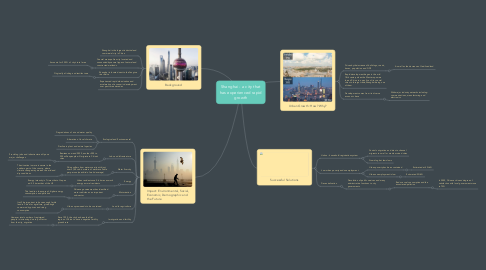
1. Urban Growth: How? Why?
1.1. Driven by theincrease of buildings, roads, buses, population and GDP
1.1.1. As well as the decrease of fertilised land
1.2. Rapid development began in the mid 18th century when the Western powers forced China to open five of its coastal cities to foreign trade,Shanghai being one of them
1.3. Development comes from its diverse economic base
1.3.1. With major industry networks including: communications, manufacturing and electronics
2. Successful Solutions
2.1. Hukou - household registration system
2.1.1. Controls migration and tries to channel migrants to small or medium-sized cities
2.1.2. Crowding but few slums
2.2. Low urban poverty and unemployment
2.2.1. Urban poverty has been contained
2.2.1.1. Estimated at 4%-6%
2.2.2. Urban unemployment is low
2.2.2.1. Estimated 3%-4%
2.3. Decentralisation
2.3.1. Devolution of public services and many adminstrative functions to city governments
2.3.1.1. Reduce coal consumption andthe associated pollution
2.3.1.1.1. In 2005, Chinese citizens' degree of satisfaction with local governments rose to 72%
3. Background
3.1. Shanghai is the largest industrial and commercial city in China
3.2. Coastal metropolitan city located and surroundedby several types of natural and constructed wetlands
3.2.1. Accounts for 23.5% of city's total area
3.3. Shanghai is located next to the Yangtze river delta
3.3.1. Originally a fishing and textiles town
3.4. Experienced rapid urbanisation and acceleration of economic development over past three decades
4. Impact: Environmental, Social, Economic, Demographic and the Future
4.1. Ecological and Environmental
4.1.1. Degradations of air and water quality
4.1.2. Alteration of local climate
4.1.3. Decline in plant and animal species
4.2. Jobs and Infrasturcture
4.2.1. Bewteen now and 2025, another 200 to 250 millionpeople will migrate to China's cities
4.2.1.1. Providing jobs and infrastructure wll pose major challenges
4.3. Water Scarcity
4.3.1. China suffers from water scarcity with just over 2,100 cubic meters of water available per person (one-third of world average)
4.3.1.1. The situation is more insecure in the northern part of the country, where climate change may worsen the arid and dry conditions
4.4. Energy
4.4.1. Urban residents use 3.6 times as much energy as rural residents
4.4.1.1. Energy intensity is 7 times that of Japan ad 3.5 times that of the US
4.5. Motorisation
4.5.1. Chinese governement has identified motor vehicles as an important sub-sector
4.5.1.1. This lead to urban sprawl, higher energy consumption and pollution
4.6. Land for agriculture
4.6.1. Urban spraw needs to be contained
4.6.1.1. It will be important to have enough fertile land in China for agriulture, giveb hugh commmodity prices and rising consumption
4.7. Immigration and fertility
4.7.1. Since 1993, the city has been the first region of China to have a negative fertility growth rate
4.7.1.1. However total number of registered people is increasing due to pull factor from the city, migration
